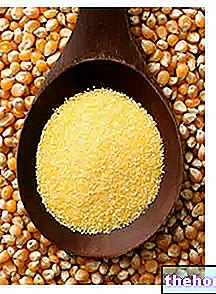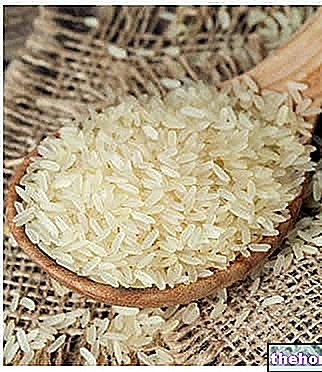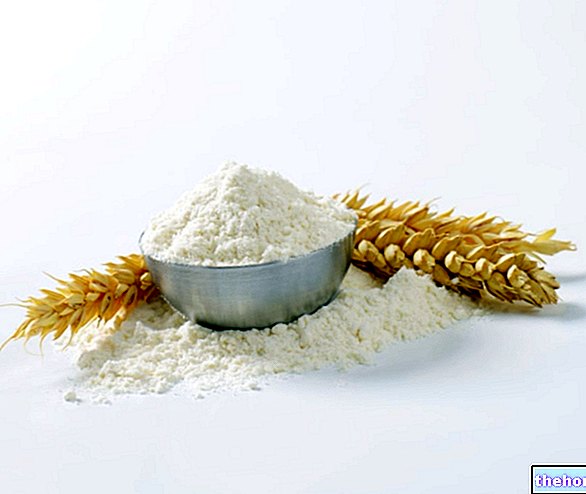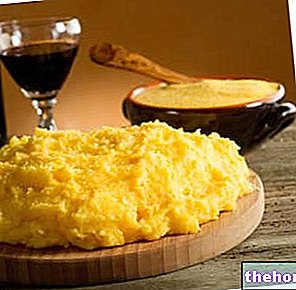What is Brown Rice?
Brown rice (in English "brown rice" or "hulled rice" or "unmilled rice") is a food of vegetable origin that belongs to the group of cereals.
Brown rice is made from the seeds of the plant Oryza sativa, of which there are many varieties (black rice, arborio rice, vialone rice, carnaroli rice, etc.).
Brown rice has a delicate hint of hazelnut; when chewed it is slightly chewy and from a chemical point of view it brings above all an "excellent quantity of carbohydrates and energy.

Differences between brown rice and white rice
Any type of rice (long, short, glutinous grain, etc.) can be sold whole or white-refined.
To produce brown rice it is sufficient to remove only the outermost fibrous layer, said chaff, while to obtain white rice the underlying layers must also be eliminated. The refining procedure is called dehulling and consists in the removal of the husk, consisting of glumellae (or bracts) and from the germ (or embryo); what remains, the "starchy endosperm, is subjected to a phase of polishing (polishing, hence the term polished rice).
Compared to white rice, brown rice includes a greater fibrous and lipid portion which, in addition to determining the dark pigmentation of the seed, characterizes: nutritional content, digestibility and absorption, metabolic impact, organoleptic properties, shelf life, cooking times and gastronomic trends.
Brown rice has longer cooking times than white rice and tends to release less starch, which is why it lends itself less to the production of risottos than white rice.
From a conservative point of view, wholemeal rice is certainly not the longest-lived rice and tends to go rancid faster due to the lipid germ.
Although considered better than refined rice, brown rice appears to contain higher amounts of inorganic arsenic, a poisonous and potentially carcinogenic substance.
Nutritional Characteristics
Brown and refined rice have similar amounts of carbohydrates and total calories. However, the former provides more lipids, proteins and fibers, while the latter boasts higher concentrations of starch; vitamins and mineral salts are also more abundant in brown rice than in refined rice.
In fact, with the separation of the husk (fibrous bracts and lipid embryo) various nutrients are lost (dietary fiber, fatty acids, fat-soluble vitamins, water-soluble vitamins and mineral salts). Among these, vit B1 (thiamine), vit PP (niacin) and iron are often added again to the refined product giving rise to the so-called "enriched white rice".

Nutritional values (per 100 g of edible portion)
It seems that, in the US, white rice producers are required by the Food and Drug Administration to apply this nutritional correction to their husked and polished products.
The only mineral not artificially reintegrated into white rice is magnesium. In fact, a 195g cup of cooked long grain brown rice provides 84mg of magnesium, while the white rice equivalent contains only 19mg. Ultimately, brown rice provides about 440% more magnesium than refined rice.
We reiterate once again that during the removal of the bran, in addition to the fibrous components, the germ is also removed. This, rich in lipids (even if, proportionally, in rice they are of modest quantity), remains instead in brown rice defining its good lipid profile (beneficial) and fat-soluble vitamins (especially vitamin E).
NB. What remains from the husking for the production of refined white rice is generally subjected to the extraction of the oil, which is also intended for sale (rice oil).
Brown Rice and Diet
From a general point of view, brown rice is a rather energetic food, rich in carbohydrates, with a significant but not excessive portion of proteins, and few lipids.
The carbohydrates are almost exclusively complex (starch), the peptides have a medium biological value and the lipids tend to be unsaturated (detail not present in the table).
The protein quality of rice is considered superior to that of pasta, although the latter is - in absolute terms - slightly richer in peptides.
Cholesterol is absent, fiber is abundant and a certain amount of phytic acid is also detectable.
As far as vitamins are concerned, B1 and PP are well present; with regard to mineral salts, on the other hand, the concentrations of iron (although not very bioavailable), magnesium, potassium and phosphorus stand out.
Brown rice has a lower glycemic index than refined rice, an aspect that makes it more suitable for the diet of the obese, type 2 diabetic, hypertriglyceridemic and, in general, those suffering from metabolic syndrome.
It also lends itself to the nutrition of vegetarians and vegans; moreover, it does not contain gluten or lactose.
Brown rice is excellent for any kind of diet, but it is necessary not to exceed the portions. Due to the considerable concentration of fibers and the presence of phytic acid, even more so in subjects suffering from chronic diarrhea, this food can cause an increase in the frequency of bowel movements, with undesirable effects such as liquid stools, flatulence, abdominal tension, malabsorption, etc. Sports enthusiasts, who can benefit from its magnesium content, must therefore take into account this portion limit.
Brown rice is very suitable for nutrition against constipation.
The average portion of brown rice should not exceed 90g raw (300kcal).
Vegan Cold Plate - Vegetable Meat Carpaccio with Brown Rice
Problems with playing the video? Reload the video from youtube.
- Go to the Video Page
- Go to the Video Recipes Section
- Watch the video on youtube
Sprouted brown rice or GABA rice
There is a method of consuming rice that is "nutritionally superior" to the others, namely sprouting before cooking.
Sprouted brown rice was invented during "the" International Year of Rice "and, compared to amorphous rice, it benefits from a significant increase in the concentrations of amino acids and GABA (gamma amino butyric acid); for this reason, sprouted brown rice (GBR) is also called GABA rice.
GABA is a non-essential amino acid produced starting from arginine, which in the body plays the role of an inhibitory neurotransmitter and which is frequently used for topical use in certain anti-wrinkle products (for more information see the article: Gamma Amino Butyric Acid) .
GABA rice is obtained by soaking the whole seeds for about 20 hours in water at 34 ° C before cooking. (Obviously, refined rice cannot germinate as it lacks the embryo.) Soaking in water stimulates germination activated by the various enzymes. Thanks to the bio-regulatory action of the latter, it is therefore possible to enjoy a more complete amino acid (and, in theory, vitamin) profile.
Arsenic in Brown Rice
A 2012 research by “Consumer Reports” found quite significant levels of arsenic in almost sixty varieties of rice and their derivatives (such as biscuits).
The institution states that brown rice contains on average 80% more inorganic arsenic than white rice of the same variety, because this pollutant tends to accumulate in the outer layers of the seed.
A 2013 study revealed that the products analyzed contained more arsenic than those of the previous year.
Furthermore, Consumer Reports stated that even a portion of these foods could have exceeded the maximum tolerable ration for a child; for this reason, in the younger population it is not recommended to exceed a weekly portion.
Other studies have also been conducted; for example, in a publication of the “National Academy of Sciences Journal” an average level of arsenic was found to be 56% higher in the urine of subjects who had consumed rice rather than other foods (sample of adult women).
storage
Brown rice has a total shelf life of about 6 months, although by means of the so-called hermetic vacuum storage or refrigeration or freezing, the shelf-life can significantly increase. Obviously, in these cases there is not always the guarantee that GABA rice can be obtained from brown rice; on the other hand, freezing it (even periodically) can effectively combat the infestations of the so-called moths. Indian Mealmoth.
Other Cereals and Derivatives Amaranth Wheat starch Corn starch Rice starch Modified starch Oat starch Bulgur Whole grains Corn Flakes Crackers Oat bran Bran Cus cus Amaranth flour Oat flour Buratto flour Spelled flour Buckwheat flour Corn flour Corn flour Millet Barley flour Quinoa flour Small spelled flour (Enkir) Rice flour Rye flour Sorghum flour Flour and semolina Whole wheat flour Manitoba flour Pizza flour Spelled Rusks Focaccia Nuts Wheat or wheat Wheat germ Burnt wheat Buckwheat Breadsticks Oat milk Rice milk Corn Maizena Malt Millet Muesli Barley Stale bread Unleavened bread and Pita Bread Carasau bread Egg pasta Rice pasta Wholemeal pasta Piadina Small spelled Pizza Pop corn Baked goods Quinoa Rice Basmati rice Converted rice White rice Rice Wholemeal Parboiled Rice Puffed Rice Venus Rice Rye and Horned Rye Semolina Semolina Sorghum Spaghetti Spelled Teff Tigelle Triticale OTHER ARTICLES CEREALS AND DERIVATIVES Categories Food Alcoholics Meat Cereals and derivatives Sweeteners Sweets Offal Fruit Dried fruit Milk and derivatives Legumes Oils and fats Fish and fishery products Salami Spices Vegetables Health recipes Appetizers Bread, Pizza and Brioche First courses Second courses Vegetables and Salads Sweets and Desserts Ice creams and sorbets Syrups, liqueurs and grappas Basic Preparations ---- In the Kitchen with Leftovers Carnival Recipes Christmas Recipes Dietary Recipes Light Recipes Woman's Day, Mother's Day, Dad's Day Functional Recipes International Recipes Easter Recipes Recipes for Celiacs Recipes for Diabetics Holiday Recipes Valentine's Day Recipes Vegetarian Recipes Protein Recipes Regional Recipes Vegan Recipes
















.jpg)











